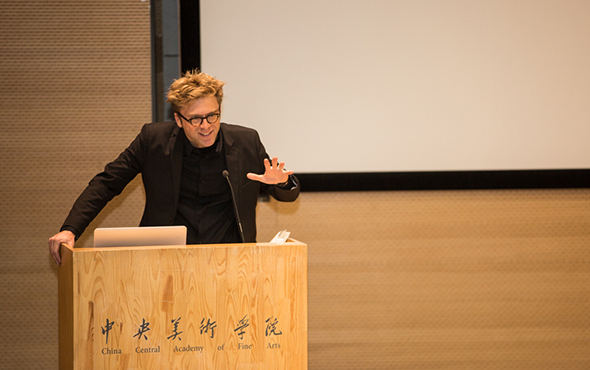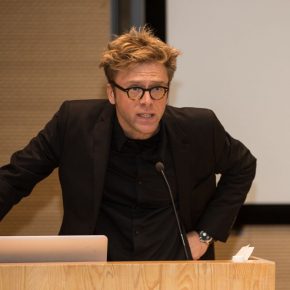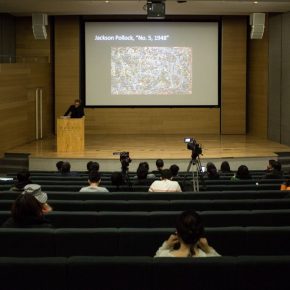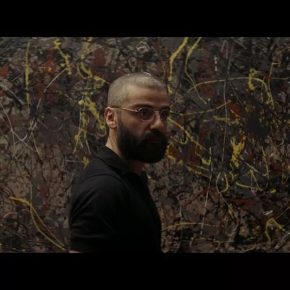
From the cultural appearance of artificial intelligence and automated trading, Pollock’s works have inspired technological innovation, which seems to be impossible. How did abstract expressionism flow to the cultural reappearance of artificial intelligence and automated trading? On the evening of December 12, 2017, as the last lecture of the “Leonardo Art, Science and Technology Series” lectures, Arne De Boever gave a lecture entitled “Automatic Art, Automated Trading”. Arne De Boever taught in the Department of Criticism and Research, California Institute of the Arts, teaching on a course of American studies, and he also serves as Director of the postgraduate course in aesthetics and political science. Although he is a teacher from the Institute of the Arts, Arne De Boever is neither an artist nor an art historian. At the lecture, he borrowed from his unique literary and economic background to explore the relationship between automatic art and the current automated trading & artificial intelligence.
Jackson Pollock was an abstract expressionist painter whose art was called “automatic art”, which was a direct analogy with one of the most abstract and complex recent neoliberal financial zones, namely the automatic trading or the trading of “black box”. This discussion also led to another abstract and complex area, namely artificial intelligence. Automated trading is driven by a program of artificial intelligence.
Automatic Art and Automated Trading??In order to explain the relationship between Pollock and both, Arne first introduced the current economic environment and its operation. Starting with the classic M-C-M’, he further elaborated the renovating theory of space and time by Steven Shaviro. At present, the capitalist financial system is no longer the market that relies on commodities shown by classical Marxism, while it often relies on financial instruments such as mortgages, securities, insurance and even student loans. Securities and stock exchanges are not crowded anymore, while people have supervision roles of the numbers, namely the so-called algorithm rather than an actual operation, and the HFT, the rapid, complex and abstract financial capitalism, poses a tremendous challenge to present a realistic performance, including both the economic theory and the art.
Prof. Arne believed that it was in need of speculative aesthetics rather than post-modern aesthetics at present. The private and unmanageable high-frequency-trading environment corresponds to the physics concepts of dark matter and black holes. In this financial reality, the essential question is: how does art help us to recognize or think of the contemporary technological infrastructure of the digital economy, and how is contemporary wealth created and produced? What can art do in this environment? Under the context of this question, we discuss Pollock’s works.
Automatic Art and Financial Novels??????????What kind of works of art appear in financial fiction? In the first neo-liberal novel “American Psycho”, which was the first financial novel, Bret Easton Ellis wrote many works by contemporary artists, but these works were just symbols of wealth. “Conceptual Art” explained the conceptual art that was born in the advent of the financial age, and both had a relationship with communion or parallel relationships. The first exhibition exclusively on conceptual art was held in 1970, at the beginning of the era of financial neoliberalism. Conceptual art has something in common with financial tools in its de-materialization, so that the appearance of works of art in financial fiction depicting financial markets is not only a sign of wealth, but also reminds people of the aesthetics – how wealth is produced in the financial age? The works in financial novels can be viewed in a conceptual sense, and contemporary art has become a tool to perfectly produce value. Prof. Arne took Jeff Koons and Damien Steven Hirst of YBA as examples, to demonstrate the conformity of contemporary art and finance.
Michael Houellebecq’s “La Carte et le Territoire” denied the art and value of the two artists previously mentioned, in the first chapter. Prof. Arne thought Houellebecq succeeded in describing the present financial environment in a realistic way, by describing the life of an artist. Pollock’s work appeared in Houellebecq’s novel with a major image. Pollock’s work became the source of inspiration for the hero’s success in Teday Wayne’s Kapitoil. Human and artificial intelligence which has a different understanding on Pollock’s work which pushed the storyline of Alex Garland’s film of “Ex Machina”.
Automatic Art and Artificial IntelligencePollock’s work plays an important role in both novels and movies. Pollock was born during the Great Depression in the United States. His work is reminiscent of the freedom of human expression, while the artificial intelligence is often associated with monitoring society and black-box society. Prof. Arne said Pollock’s work was not directly related to the two. Pamela Lee’s “Think-Tank Aesthetics” stated that Pollock considered his works as reproductions, while Lee connected it with the military organizations in the United States in the Cold-War era, calling it “a combination of military and aesthetics”. During the Cold-War era, intelligence agencies such as the CIA analyzed the abstract form to find the object of reappearance, and predicted the enemy’s actions based on an analysis of the result. Lee believed that the three fields of anthropology, military affairs and art should be brought together, in order to see the parallel relations between them both again under the historical conditions of the time. This relationship was not only established at that time, while the things that the military organizations were interested in have continued in the current digital age.
Which artists continue Pollock’s ideas? Tyson’s “Junction Box” placed variances in the algorithms so that it automatically generated an artwork and became the contemporary “Automatic Art”. In the curatorial field, curator Aude Launay used the algorithms invented by Canadian artists to make an exhibition. Artists using algorithms for art have also started to focus on the financial sector. One of projects by the French art group RYBN is an art project on tax havens. RYBN treats finance as a playground for the art, observing finance in an artistic way. Prof. Arne believed that RYBN was a contemporary successor to the issues raised by Lee’s discussion of Pollock, and beyond Lee’s combination of military and aesthetics, it reveals a mixture of military, aesthetics and economy, and the issues of mixture, which were discussed in this lecture, are worth being explored.
Text by Wu Huixia, translated by Chen Peihua and edited by Sue/CAFA ART INFO
Photo by Hu Sichen/CAFA ART INFO




































